ASRock FM2A88X Extreme6+ Review
by Ian Cutress on March 19, 2014 11:59 AM ESTScientific and Synthetic Benchmarks
2D to 3D Rendering –Agisoft PhotoScan v1.0: link
Agisoft Photoscan creates 3D models from 2D images, a process which is very computationally expensive. The algorithm is split into four distinct phases, and different phases of the model reconstruction require either fast memory, fast IPC, more cores, or even OpenCL compute devices to hand. Agisoft supplied us with a special version of the software to script the process, where we take 50 images of a stately home and convert it into a medium quality model. This benchmark typically takes around 15-20 minutes on a high end PC on the CPU alone, with GPUs reducing the time.
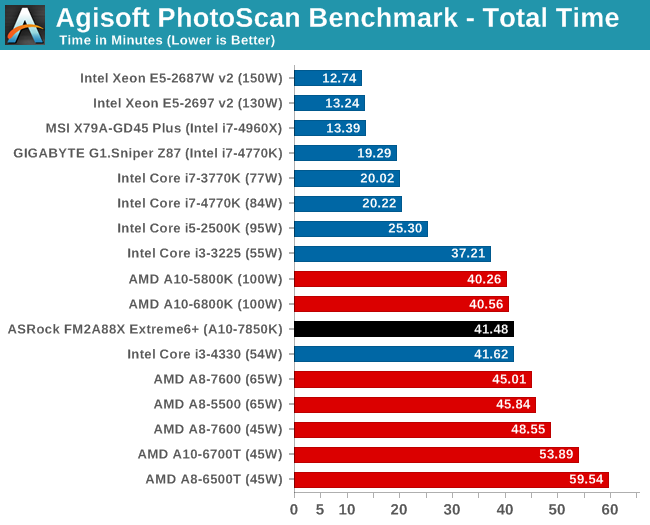
Console Emulation –Dolphin Benchmark: link
At the start of 2014 I was emailed with a link to a new emulation benchmark based on the Dolphin Emulator. The issue with emulators tends to be two-fold: game licensing and raw CPU power required for the emulation. As a result, many emulators are often bound by single thread CPU performance, and general reports tended to suggest that Haswell provided a significant boost to emulator performance. This benchmark runs a Wii program that raytraces a complex 3D scene inside the Dolphin Wii emulator. Performance on this benchmark is a good proxy of the speed of Dolphin CPU emulation, which is an intensive single core task using most aspects of a CPU. Results are given in minutes, where the Wii itself scores 17.53; meaning that anything above this is faster than an actual Wii for processing Wii code, albeit emulated.
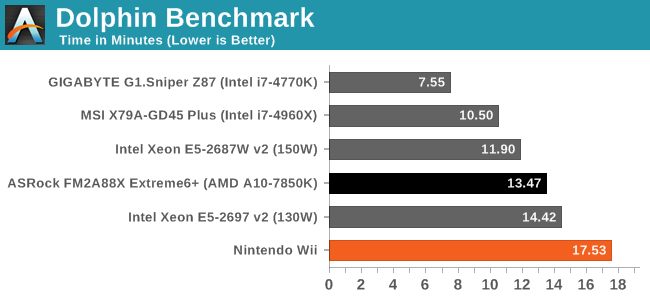
Point Calculations – 3D Movement Algorithm Test: link
3DPM is a self-penned benchmark, taking basic 3D movement algorithms used in Brownian Motion simulations and testing them for speed. High floating point performance, MHz and IPC wins in the single thread version, whereas the multithread version has to handle the threads and loves more cores.
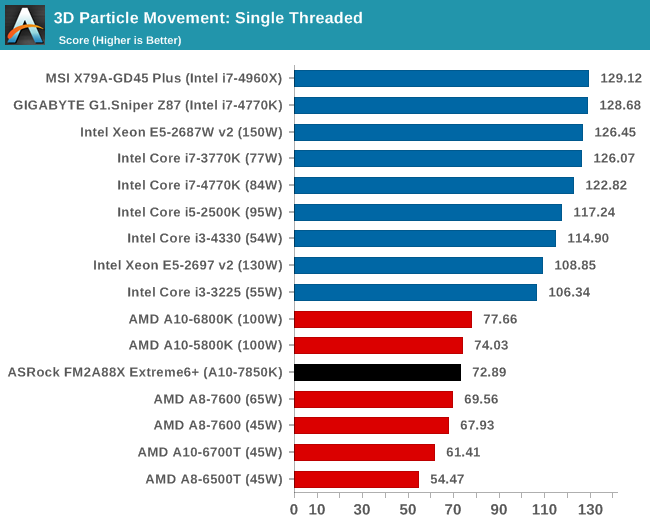
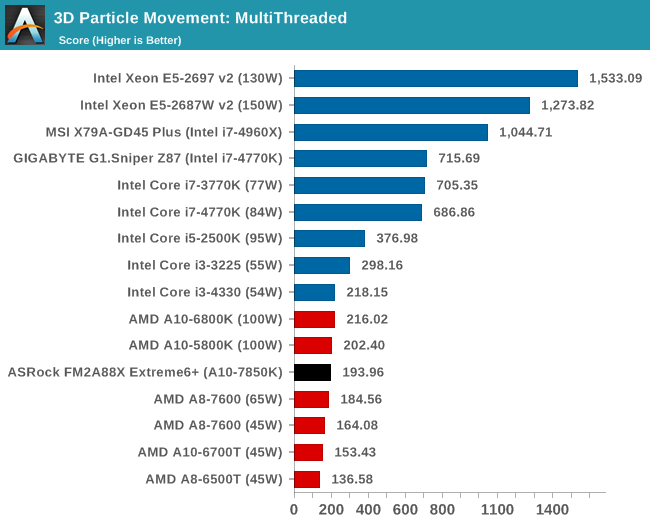
Encryption –TrueCrypt v0.7.1a: link
TrueCrypt is an off the shelf open source encryption tool for files and folders. For our test we run the benchmark mode using a 1GB buffer and take the mean result from AES encryption.
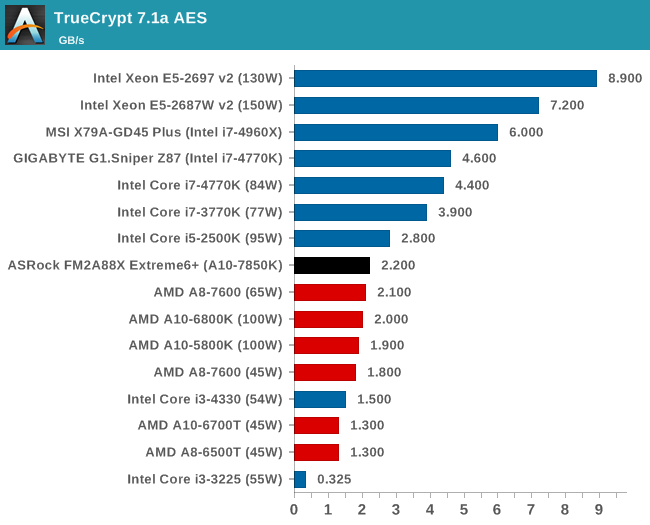
Synthetic – 7-Zip 9.2: link
As an open source compression tool, 7-Zip is a popular tool for making sets of files easier to handle and transfer. The software offers up its own benchmark, to which we report the result.
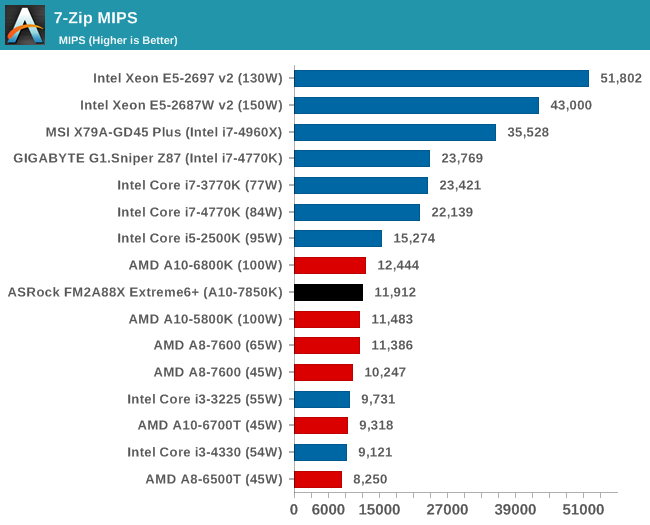










44 Comments
View All Comments
5thaccount - Thursday, March 20, 2014 - link
I know this isn't a review of the APU, but I'm very curious why it wasn't benched against a Celeron / i3 / i5 in the system and game benchmarks. I wouldn't expect this to come near i7 / Xeon territory (although, to it's credit, it did better than I was expecting). Was it only to strictly compare relative performance to the fastest Intel can provide? I'd be curious to see how it fared against similarly priced and cheaper Intel CPUs - especially in the game benchmarks.aike - Friday, March 21, 2014 - link
All the shock practice on the devices can be used keep on effort just by advantage about keeping effort or possibly at home process. All the devices undeniably construct over to any <a href="http://www.katalog.cc/">rolex replica</a> private??? lenses temperament, considering that it adds something to a?? lenses is visually and additionally trend.aike - Friday, March 21, 2014 - link
Genuinely, each one of on top of exploit fundamental purpose typically the copy wholesale handbags turned out to be some type of shrewd undermine concerning trendy finishing touches an increasing number of gals get to approve perhaps even booty.http://www.oakleafgardenmachinery.co.uk/superrepli...DrMrLordX - Saturday, March 22, 2014 - link
Thank you for taking the time to review this board, Mr. Cutress. I am curious about CPU throttling under heavy IGP load. Did you experience this problem? Some have attributed this to VRM temperatures, but others have observed that this may be related to a design decision on AMD's part to keep total power delivery to the chip within a specific TDP envelope, even when overclocking is present.I have been trying to figure out which AM2+ boards can mitigate or defeat this throttling behavior through UEFI settings. There is another way not involving the UEFI:
http://www.overclock.net/t/1459225/i-have-custom-l...
but it would be much nicer to tweak the UEFI to defeat this p5 state behavior. People with "good" cooling on the CPU and VRMs are still getting throttling, at least on some boards, some of the time . . . it's hard to nail down exactly who has this problem.